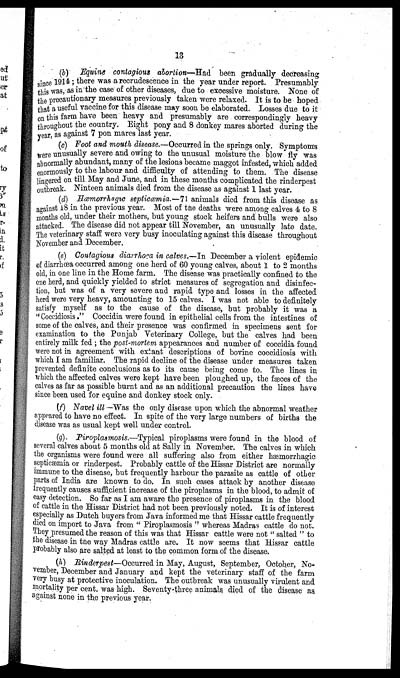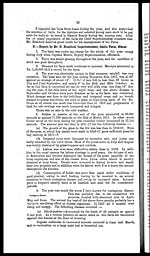Medicine - Veterinary > Civil Veterinary Departments > 1894-1932 - Annual report of the Punjab Veterinary College and of the Civil Veterinary Department, Punjab > 1909-1919 > 1917-1918 - Annual report on the Punjab Veterinary College, Civil Veterinary Department, Punjab, and the Government cattle farm, Hissar, for the year 1917-18
(431) Page 13
Download files
Individual page:
Thumbnail gallery: Grid view | List view

13
(b) Equine contagious abortion—Had been gradually decreasing
since 1914; there was a recrudescence in the year under report. Presumably
this was, as in the case of other diseases, due to excessive moisture. None of
the precautionary measures previously taken were relaxed. It is to be hoped
that a useful vaccine for this disease may soon be elaborated. Losses due to it
on this farm have been heavy and presumably are correspondingly heavy
throughout the country. Eight pony and 8 donkey mares aborted during the
year, as against 7 pon mares last year.
(c) Foot and mouth disease.—Occurred in the springs only. Symptoms
were unusually severe and owing to the unusual moisture the blow fly was
abnormally abundant, many of the lesions became maggot infested, which added
enormously to the labour and difficulty of attending to them. The disease
lingered on till May and June, and in these months complicated the rinderpest
outbreak. Ninteen animals died from the disease as against 1 last year.
(d) Hæmorrhagic septicæmia.—71 animals died from this disease as
against 18 in the previous year. Most of the deaths were among calves 4 to 8
months old, under their mothers, but young stock heifers and bulls were also
attacked. The disease did not appear till November, an unusually late date.
The veterinary staff were very busy inoculating against this disease throughout
November and December.
(e) Contagious diarrhoea in calves.—In December a violent epidemic
of diarrhœa occurred among one herd of 60 young calves, about 1 to 2 months
old, in one line in the Home farm. The disease was practically confined to the
one herd, and quickly yielded to strict measures of segregation and disinfec-
tion, but was of a very severe and rapid type and losses in the affected
herd were very heavy, amounting to 15 calves. I was not able to definitely
satisfy myself as to the cause of the disease, but probably it was a
" Coccidiosis." Coccidia were found in epithelial cells from the intestines of
some of the calves, and their presence was confirmed in specimens sent for
examination to the Punjab Veterinary College, but the calves had been
entirely milk fed ; the post-mortem appearances and number of coccidia found
were not in agreement with extant descriptions of bovine coccidiosis with
which I am familiar. The rapid decline of the disease under measures taken
prevented definite conclusions as to its cause being come to. The lines in
which the affected calves were kept have been ploughed up, the fæces of the
calves as far as possible burnt and as an additional precaution the lines have
since been used for equine and donkey stock only.
(f) Navel ill —Was the only disease upon which the abnormal weather
appeared to have no effect. In spite of the very large numbers of births the
disease was as usual kept well under control.
(g) Piroplasmosis.—Typical piroplasms were found in the blood of
several calves about 5 months old at Sally in November. The calves in which
the organisms were found were all suffering also from either hæmorrhagic
septicæmia or rinderpest. Probably cattle of the Hissar District are normally
immune to the disease, but frequently harbour the parasite as cattle of other
parts of India are known to do. In such cases attack by another disease
frequently causes sufficient increase of the piroplasms in the blood, to admit of
easy detection. So far as I am aware the presence of piroplasms in the blood
of cattle in the Hissar District had not been previously noted. It is of interest
especially as Dutch buyers from Java informed me that Hissar cattle frequently
died on import to Java from " Piroplasmosis " whereas Madras cattle do not.
They presumed the reason of this was that Hissar cattle were not " salted " to
the disease in the way Madras cattle are. It now seems that Hissar cattle
probably also are salted at least to the common form of the disease.
(h) Rinderpest—Occurred in May, August, September, October, No-
vember, December and January and kept the veterinary staff of the farm
very busy at protective inoculation. The outbreak was unusually virulent and
mortality per cent. was high. Seventy-three animals died of the disease as
against none in the previous year.
Set display mode to: Large image | Zoom image | Transcription
Images and transcriptions on this page, including medium image downloads, may be used under the Creative Commons Attribution 4.0 International Licence unless otherwise stated. ![]()
| Permanent URL | https://digital.nls.uk/75532694 |
|---|
| Additional NLS resources: |
|---|




